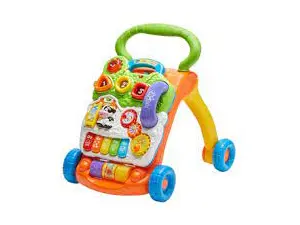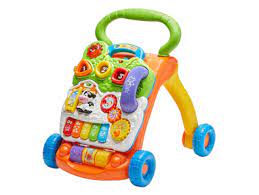Unlocking Potential: The Power of Early Development Toys in Nurturing Young Minds
Early development toys are specially designed playthings that stimulate a child's senses and promote various aspects of their growth. From sensory exploration to fine motor skill development, these toys play a crucial role in laying the foundation for a child's cognitive, emotional, and physical development during their formative years.
Types of Early Development Toys: A Comprehensive Guide

The early years of a child's life are a period of rapid growth and development. During this crucial time, providing the right stimulation and tools can have a profound impact on a child's cognitive, emotional, and physical development. Early development toys play a pivotal role in creating an enriching environment that fosters learning and growth.
Early development toys hold a pivotal role in shaping a child's foundational skills and abilities. During the early years of life, a child's brain undergoes rapid and intricate development. This period, often referred to as the critical window, is marked by heightened neural plasticity, allowing the brain to form crucial connections and pathways. Early development toys are strategically designed to capitalize on this period of heightened neuroplasticity.
One of the primary benefits of early development toys lies in their ability to stimulate sensory exploration. These toys come in a variety of textures, colors, and shapes, engaging a child's senses of touch, sight, sound, and sometimes even taste. This sensory engagement allows children to begin comprehending and interacting with their environment in a meaningful way. For example, toys like soft fabric books with varying textures or rattles with different sounds encourage infants to explore their surroundings through touch and sound.
Types of Early Development Toys
Early development toys encompass a diverse range of playthings specifically designed to nurture various aspects of a child's growth and development. These toys cater to sensory exploration, fine motor skills, cognitive abilities, language development, and social-emotional growth.
- Sensory Toys: Sensory toys are designed to engage a child's senses, providing opportunities for exploration and understanding of the world around them. These toys come in various textures, shapes, and materials, encouraging tactile, visual, and auditory stimulation. Examples include soft fabric books with different textures, textured balls, and rattles with various sounds.
- Fine Motor Skill Toys: Fine motor skill toys focus on developing the small muscles in a child's hands and fingers. These toys provide activities that require precise movements and coordination. Examples include stacking blocks, threading beads, using playdough, and puzzles with small pieces. These activities help refine hand-eye coordination, grip strength, and dexterity.
- Cognitive Development Toys: These toys challenge a child's mind, encouraging problem-solving, critical thinking, and spatial awareness. Activities like building blocks, shape sorters, and puzzles stimulate cognitive growth. Through these toys, children learn to analyze, strategize, and make decisions, laying the foundation for more complex cognitive skills.
- Language and Communication Toys: Toys in this category are designed to facilitate language development. They introduce new words, sounds, and concepts, promoting early language skills. Board books with colorful pictures and simple words, puppets for interactive storytelling, and imaginative playsets with characters and scenes all contribute to enhancing a child's language and communication abilities.
- Social-Emotional Development Toys: Many early development toys promote cooperative play, allowing children to interact with others and learn important social skills. Sharing toys, role-playing with dolls or action figures, and engaging in pretend play scenarios help children build empathy, emotional intelligence, and a sense of cooperation. These toys encourage the development of social skills, emotional regulation, and understanding of others' perspectives.

Choosing the Right Early Development Toy
Selecting the right early development toy for a child involves careful consideration of their age, interests, and current developmental stage.
- Consider Age-Appropriateness: Ensure that the toy is suitable for the child's age and developmental level. Manufacturers often provide age recommendations on the packaging to guide your selection. Choosing toys that align with the child's current stage of development ensures they can engage with the toy in a meaningful and safe way.
- Match the Toy to the Child's Interests: Pay attention to the child's preferences and interests. If a child is naturally drawn to certain activities or themes, selecting toys that align with those interests can foster a genuine love for learning and exploration.
- Promote Multi-Sensory Engagement: Look for toys that engage multiple senses. Toys with different textures, vibrant colors, varying sounds, and interactive features provide a rich sensory experience, which is crucial for early development.
- Encourage Open-Ended Play: opt for toys that allow for imaginative and open-ended play. These toys empower children to use their creativity and problem-solving skills, promoting independent thinking and self-expression.
- Consider Developmental Milestones: Familiarize yourself with typical developmental milestones for a child's age range. This knowledge can guide you in selecting toys that target specific skills or areas of development. For example, if a child is working on fine motor skills, choosing toys that involve manipulating small objects can be beneficial.
- Safety First: Prioritize safety when choosing early development toys. Ensure that the toy is free from small parts that could be choking hazards, and opt for toys made from non-toxic materials. Check for any sharp edges or potential points of entrapment. Always follow manufacturer's guidelines for age-appropriateness and supervision.
- Quality Over Quantity: Investing in well-made, durable toys can provide long-lasting benefits. High-quality toys are more likely to withstand the rigors of play and continue to engage a child's interest over time.
- Consider Multi-Purpose Toys: Look for toys that offer a range of play experiences. For example, building blocks can be used for stacking, sorting, and imaginative play, making them versatile tools for learning and development.
- Rotate Toys for Variety: Introduce a variety of toys to keep playtime engaging and stimulating. Rotating toys in and out of a child's play space can maintain their interest and provide new learning opportunities.
Safety Considerations
Safety is paramount when it comes to selecting and using early development toys for children.
- Age-Appropriate Toys: Ensure that the toy is suitable for the child's age and developmental stage. Manufacturers provide age recommendations to help guide your selection. Avoid toys with small parts that can be choking hazards for younger children.
- Non-Toxic Materials: Choose toys made from non-toxic materials. Look for labels or certifications indicating that the toy meets safety standards for children's products. Avoid toys with harmful chemicals or lead-based paints.
- Avoid Sharp Edges or Points: Inspect toys for any sharp edges, corners, or points that could potentially cause injury. Smooth, rounded edges are safer for young children to handle.
- Securely Attached Parts: Check that all parts of the toy are securely attached. Loose components or small detachable pieces pose a choking hazard. Pay special attention to eyes, buttons, or other small embellishments.
- Sturdy Construction: Ensure that the toy is well-constructed and durable. It should be able to withstand normal play without easily breaking or splintering, which can lead to sharp edges or small pieces.
- Battery Compartment Safety: If the toy requires batteries, make sure the battery compartment is secure and not easily accessible to the child. Also, use only the type and quantity of batteries recommended by the manufacturer.
- Avoid Toys with Strings or Cords: Long strings, cords, or ribbons can pose a strangulation hazard for young children. If a toy has these features, ensure they are short and securely attached.
- Supervision and Guidance: Always supervise playtime, especially for younger children. Provide appropriate guidance on how to use the toy safely and demonstrate any potential risks.
- Check for Recalls: Stay informed about toy recalls by regularly checking for updates from trusted sources. If a toy is recalled due to safety concerns, discontinue use immediately.
- Store Toys Safely: When playtime is over, store toys in a safe and organized manner. Keep small parts and toys with strings or cords out of reach to prevent accidental ingestion or strangulation.
- Regular Inspections: Periodically inspect toys for signs of wear and tear. Dispose of any damaged or broken toys to prevent potential hazards.
- Follow Manufacturer's Instructions: Adhere to any specific usage or assembly instructions provided by the manufacturer. This includes weight limits for ride-on toys and assembly guidelines for complex toys.

What is the best toy for child development
The best toy for child development depends on the child's age, interests, and specific areas of focus for development.
- Infants (0-12 months):
- Soft Sensory Toys: Soft, textured toys provide tactile stimulation and are safe for babies to explore by touch and mouth.
- High-Contrast Toys: Toys with bold patterns and high-contrast colors are visually stimulating for infants with developing vision.
- Toddlers (1-3 years):
- Building Blocks: These promote fine motor skills, spatial awareness, and creativity.
- Puzzles: Simple puzzles with large, easy-to-grasp pieces help with problem-solving and hand-eye coordination.
- Play Kitchen or Tool Set: Encourages imaginative play and role-playing.
- Preschoolers (3-5 years):
- Art Supplies: Crayons, markers, and playdough foster creativity, fine motor skills, and self-expression.
- Board Games: Simple board games introduce concepts like turn-taking, counting, and strategic thinking.
- Dress-Up Clothes and Props: Encourages imaginative play and role-playing.
- Kindergarteners and School-Aged (5+ years):
- Educational Games and Puzzles: More complex games that focus on math, language, and critical thinking skills.
- Building and Construction Sets: Encourages problem-solving, creativity, and spatial awareness.
- Books and Reading Material: Foster language development, imagination, and a love for reading.
- Open-Ended Toys (All Ages):
- Blocks: Wooden or magnetic blocks can be used in a variety of ways to promote creativity, problem-solving, and fine motor skills.
- Playdough: Provides endless opportunities for imaginative play, fine motor skill development, and creativity.
- Art Supplies: Including items like paper, markers, glue, and scissors, which promote creativity and fine motor skills.
Early development toys are powerful tools that lay the foundation for a child's future success and well-being. By providing opportunities for sensory exploration, fine motor skill development, cognitive growth, language enhancement, and social-emotional learning, these toys offer a holistic approach to early childhood development. Parents, caregivers, and educators play a crucial role in selecting and facilitating play with these toys. By embracing the importance of early development toys, we empower children to unlock their full potential and embark on a lifelong journey of learning and growth.



